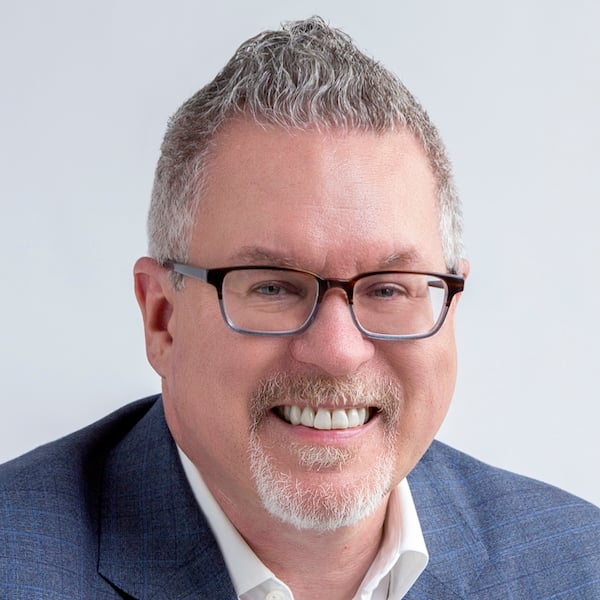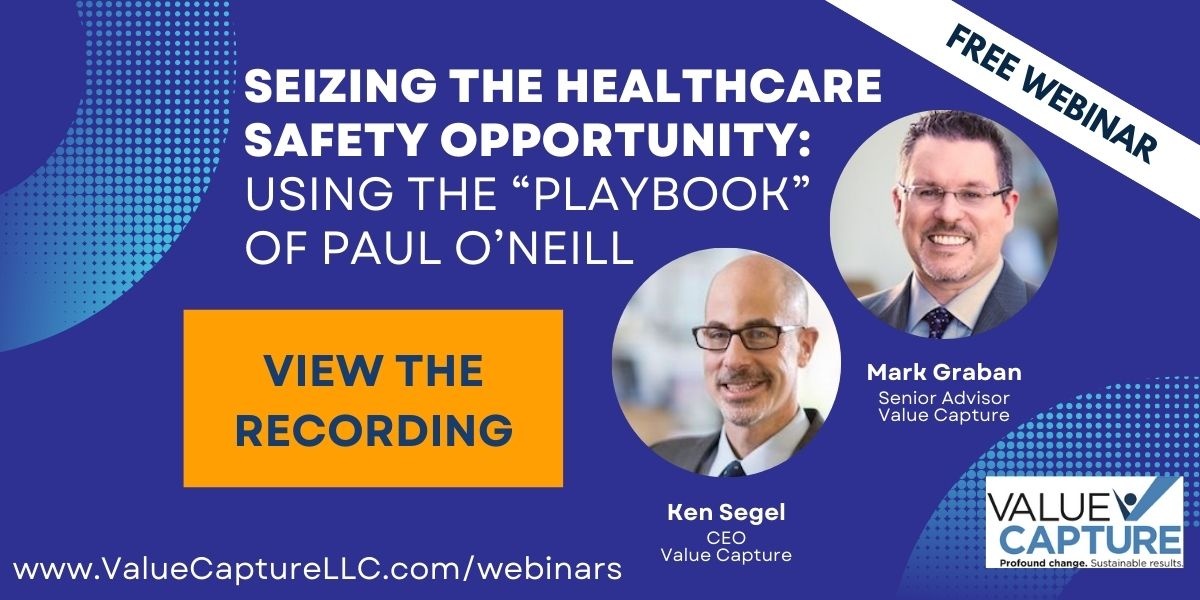As I wrote about in May, Ken Segel (our CEO) and I were invited to speak together at the Michigan Lean Consortium's annual conference in August. We were honored to be there.
We got very good feedback about the talk we gave. I wanted to share a few thoughts from those days in Traverse City -- in particular, the complementary nature of our talk about the leadership principles of Paul O'Neill and the ideas that were shared about "joy in work" by Rich Sheridan, CEO of a software company, Menlo Innovations.
Our talks were very different, with some different language, but I think the spirit of them was very similar (and I think Rich agreed when we chatted afterward).
Before getting to my notes on Rich's talk, I wanted to let you know that Ken and I are going to be presenting a free webinar version of our talk, version 2.1 or so, on October 18th. We hope that you'll join us then (or afterward to view the recording). Click the image below for the registration page:
Rich is the author of two books about "joy" in the workplace and how to create it:
- Joy, Inc.: How We Built a Workplace People Love
- Chief Joy Officer: How Great Leaders Elevate Human Energy and Eliminate Fear
Rich is a very inspiring leader. I've had the opportunity to visit the Menlo office in Ann Arbor, and I've interviewed him twice for my Lean podcast.
He's a great speaker, very thought-provoking. Looking back at my notes, this was the first thing I jotted down:
"The opposite of courage is not cowardice, it's conformity."
Rich says he and his company are "committed to non-conforming ways of doing things."
My thoughts: Now, non-conforming isn't always going to be better, but when you commit to not just accepting the status quo, you have the potential for great things to happen.
If you're a healthcare leader, how can you inspire beneficial non-conformity? Can you decide to not conform to the typical thinking about patient harm? To have better thinking and better actions?
Can you commit to zero harm instead of saying that you want to be 5% better or that you want to be in the top decile compared to others?
What other examples of non-conformity should healthcare executives aspire to? Which have you embraced? Leave us a comment on the bottom of the post if you want to share.
Rich Apologizes on Behalf of the Software Industry
As the leader of a software company, Rich did address the healthcare people in the room by saying the following about EHR / EMR systems:
"I want to apologize for what my industry does to your industry."
My Thoughts: Leaders who are committed to habitual excellence, take responsibility for problems instead of denying or deflecting, among other key habits and behaviors. Rich does that, even if he isn't creating that software there at Menlo.
How often do healthcare leaders apologize for what healthcare does to harm patients, or do we deny and deflect? Paul O'Neill would want us to embrace the real reality and then get to work fixing the problems that cause harm.
It's not just a problem for healthcare, as Rich later talked about how manufacturing companies are "kow-towing to the ERP system, while running the company on spreadsheets."
My thoughts: Can the same be said about EHR / EMR systems and other workarounds that people in health systems end up employing?
How can we shift from workarounds to real improvement?
The Journey and the Long Road
People often talk about transformations in terms like, "it's a journey."
Rich used the metaphor of a "long and winding road" to illustrate this concept. Transformational change is hard, and it's never a simple straight-line path.
"Going through a tough road is normal."
We shouldn't be surprised to face challenges along the way.
My thoughts: We can treat them as learning opportunities and changes to adjust in a Plan-Do-Study-Adjust manner.
Rich talked about driving through a tunnel on the journey and how:
"You don't know if that light at the end of the tunnel is a train."
You might want to be optimistic, but you might also want to check your positive or hopeful assumptions as soon as you can!
Chaos and Bureaucracy
Rich also talked about how if you're "living in chaos too long, bad things happen" and that's true in software or in hospitals. But he warned against going "from chaos to bureaucracy,"
My thoughts: If we have chaos as a starting point in healthcare, putting some procedures or "standardized work" in place can be very helpful. But, many people fear that this means bureaucracy. That's not the case if you let people use judgment as they create standardized work -- making sure that it's not inappropriately rigid and certainly making sure that standardized work is continuously improved instead of getting fossilized.
Rich added this: If an organization tries to put structure in place, will they be tempted to "throw it all out" and say "it didn't work" when the truth might really be "we prefer chaos"?
Chief Optimist
Rich said that he chooses to be the "chief optimist" in his company.
"In a room full of manure, I know there's a pony in there somewhere. I look for the pony."
My thoughts: Habitual excellence leaders are realists in that they don't shy away from the real reality, which includes the real data about harm to patients and staff.
But, at the same time, they're optimistic that we can figure out how to make significant progress each year toward zero harm. We believe in our people and their abilities to get better at problem solving each and every day.
We can't let "it's not possible" become a self-limited belief.
"Zero harm isn't possible," some would say.
We can't let the difficult of a challenge keep us from trying.
Rich talked about how, during the time of the Wright Brothers, many believed that it "was not possible to fly more than two people on a plane" because of the weight.
Is it "impossible" or have we "just not figured out how to do it yet"?
Avoid Sucking the Life Out of the Organization
Rich lamented the "waste of human energy" and how 60% of American employees are "disengaged" when we look across industries.
My thoughts: The Paul O'Neill "playbook" shows how leaders can boost energy in the organization, partly by engaging all of them in the important challenges that we face. Leaders who are empowering, while still being directly involved and supportive (instead of just delegating) create more energy in the workplace, if not more "joy," the word Rich would use.
Here's how Rich says we could "suck the human life out of an organization" (and, of course, we want to avoid this):
- Lots of meetings
- No decisions
- If a decision is made accidentally, don't act on it
Value Capture teaches proven models, methods, and mindsets that get healthcare leaders out of the meeting rooms and out into the actual work. Instead of having monthly meetings about safety and quality, get out there and react to each and every risk or incident that harms somebody. Get better at Real-Time Problem Solving and do so on top of a foundation of Psychological Safety.
To add more energy, Rich says leaders need to ask, and then answer, two key questions:
- Who do you serve?
- What would delight look like?
Paul O'Neill said that leaders need to ask three key questions. And they need to create an environment that allows everybody to say "yes" every day.
Building a Culture of Joyful Leadership
How do leaders build joy? Here's Rich's playbook, if you will:
- Start with purpose
- Value leaders, not bosses
- Pursue systems, not bureaucracy
- Care for the team
- Learn together
- Become storytellers
Rich was honest about his own personal transformation as a leader, which I appreciated. He admitted that he "was really good at leading through fear... because that was imprinted on me."
To his credit, he's learned and adjusted, shifting his style to be a better leader -- and that leads to better results.
Wrapping up, Rich emphasized how we need to run experiments in the workplace, advising us to:
- Fight fear
- Embrace change
- Run the experiment
He shared these thoughts before wrapping up:
- Take action over taking a meeting
- Favor small experiments over committees
Again, Value Capture would love to help you with those improvement experiments... let us know if you want to talk.
In the meantime, we hope to see you at our webinar to learn more about Paul O'Neill playbook and how you can apply it right now:

Written by Mark Graban
Mark Graban has served healthcare clients since 2005. Mark is internationally recognized as a leading author and speaker on Lean healthcare. His latest book is "The Mistakes That Make Us: Cultivating a Culture of Learning and Innovation."


Submit a comment